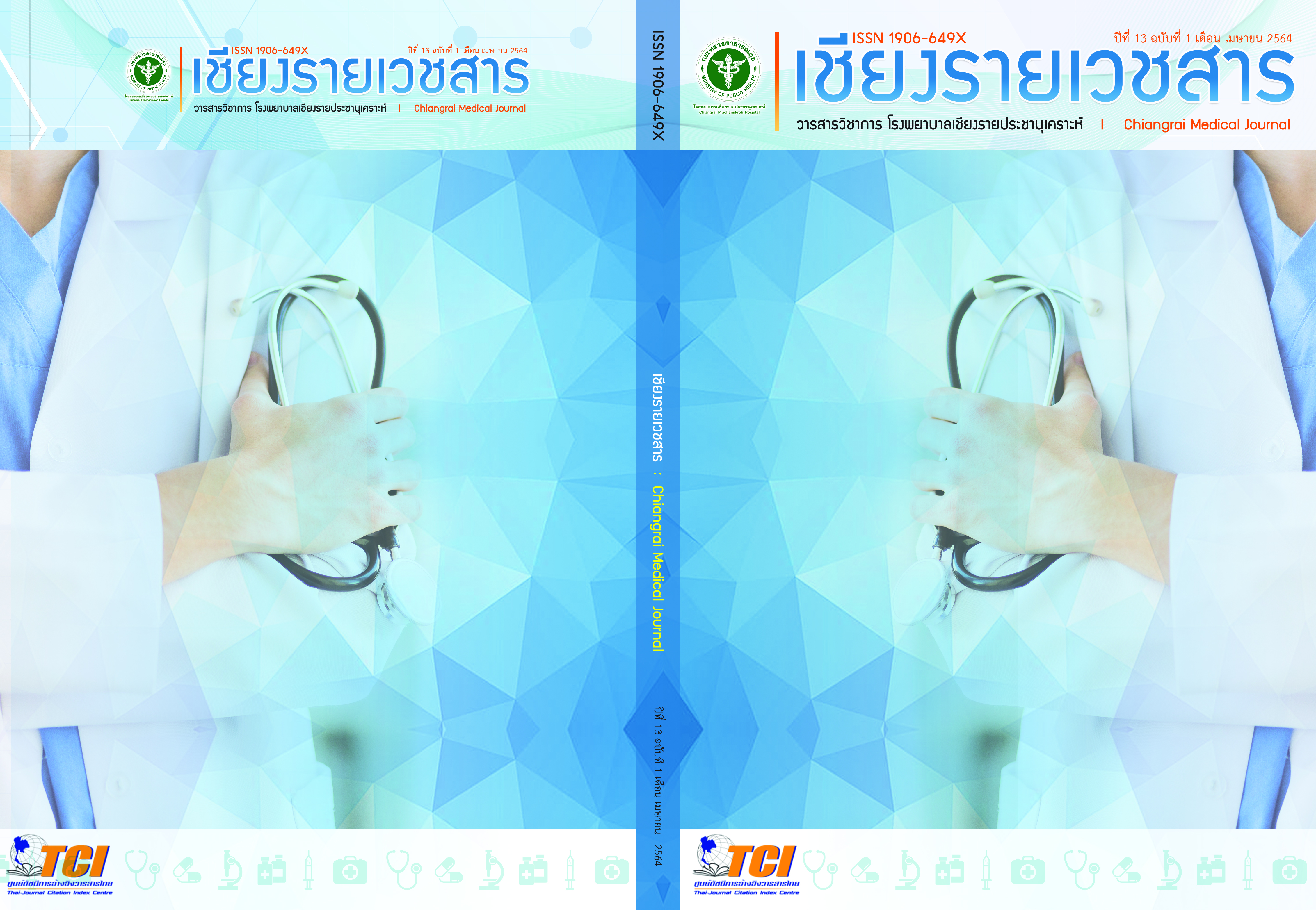การเปรียบเทียบอัตราการสั่งจ่ายยาปฏิชีวนะที่ห้องฉุกเฉินเพื่อป้องกันการติดเชื้อในแผลสุนัขหรือแมวกัดและอัตราการติดเชื้อของแผลในกลุ่มที่ใช้เกณฑ์ในการสั่งจ่ายยาปฏิชีวนะของโรงพยาบาลเทียบกับกลุ่มที่ไม่ใช้เกณฑ์
Main Article Content
บทคัดย่อ
ความเป็นมา: ประเทศไทยมีผู้ป่วยถูกสัตว์กัดปีละมากกว่า1 ล้านคน เกินร้อยละ 80 ได้รับยาปฏิชีวนะเพื่อป้องกันแผลติดเชื้อ การใช้ยาปฏิชีวนะที่ไม่เหมาะสม เกินจำเป็น ทำให้เกิดเชื้อดื้อยา
วัตถุประสงค์: เพื่อทดสอบว่า หากสั่งยาปฏิชีวนะป้องกันการติดเชื้อจากแผลสุนัขหรือแมว ตามเกณฑ์ผู้วิจัยปรับจากแนวทางเวชปฏิบัติจากในและต่างประเทศ เทียบกับการสั่งจ่ายยาโดยไม่ใช้เกณฑ์ จะช่วยลดอัตราการสั่งยาปฏิชีวนะที่ไม่เหมาะสมโดยที่อัตราเกิดแผลติดเชื้อวันที่ 3 ของสองกลุ่มไม่แตกต่างกัน
วิธีการศึกษา: การวิจัยสังเกตเชิงวิเคราะห์ เก็บข้อมูลกลุ่มตัวอย่างอายุ 15 ปีขึ้นไป มาด้วยมีบาดแผลจากสุนัขหรือแมว ณ. ห้องอุบัติเหตุ-ฉุกเฉิน โรงพยาบาลสมเด็จพระเจ้าตากสินมหาราช ตั้งแต่ 18 ตุลาคม- 18 ธันวาคม 2563 จำนวน 129 ราย แบ่งเป็น 2 กลุ่ม โดยกลุ่มควบคุมคือกลุ่มที่แพทย์สั่งยาผู้ป่วยได้โดยไม่มีเกณฑ์กำกับ กลุ่มทดลองคือกลุ่มซึ่งถูกควบคุมการสั่งยาโดยใช้เกณฑ์ ใช้แบบเก็บข้อมูล 2 ส่วน ส่วนแรกใช้ในวันที่ 1 ที่มารักษา ส่วนที่ 2 ใช้ในวันที่ 3 เพื่อเก็บข้อมูลแผลติดเชื้อ นำเสนอข้อมูลเป็นความถี่ ร้อยละ ค่าเฉลี่ย ส่วนเบี่ยงเบนมาตรฐาน วิเคราะห์ข้อมูลโดยสถิติ Chi-square test, Fisher exact, Independent t-test ใช้นัยสำคัญทางสถิติที่ 0.05
ผลการศึกษา: กลุ่มควบคุม (ร้อยละ 88.6) สั่งจ่ายยาปฏิชีวนะมากกว่ากลุ่มทดลอง (ร้อยละ 76.3) p=0.064 เมื่อวิเคราะห์เฉพาะกลุ่มแผลสุนัขกัด กลุ่มควบคุม (ร้อยละ 95.1) สั่งจ่ายยาปฏิชีวนะมากกว่ากลุ่มทดลอง (ร้อยละ 77.4) p=0.033 ส่วนอัตราการติดเชื้อของกลุ่มควบคุม (ร้อยละ 2.9) มากกว่าเมื่อเทียบกับกลุ่มทดลอง (ร้อยละ 1.7) p=1.000
ข้อสรุปและข้อเสนอแนะ: จากผลวิจัยสามารถนำเกณฑ์การสั่งจ่ายยาปฏิชีวนะปรับใช้กับบริบทห้องอุบัติเหตุ-ฉุกเฉินได้ ช่วยลดเรื่องการสั่งยาที่เกินจำเป็น เพราะอัตราการติดเชื้อไม่ต่างกันโดยนัยสำคัญสถิติ
Article Details
เอกสารอ้างอิง
2. Baxter M, Denny KJ, Keijzers G.Antibiotic prescribing in patients who presented to the emergency department with dog bites: A descriptive review of current practice. Emergency medicine Australasia.2020;32(4):578-85.
3. Saovabha memorial institute.Guidelines for the treatment of Rabies (Translate from Thai Language) [Internet]. 2016 [cited 2020 Sep 15].Available from:https://saovabha.redcross.or.th/download/2559/thailand%20Rabies-Free/QsmiGuidline2016.pdf.
4. Abrahamian FM, Goldstein EJ. Microbiology of animal bite wound infections. Clinical microbiology reviews. 2011;24(2):231-46.
5. Rothe K, Tsokos M, Handrick W.Animal and human bite wounds.Deutsches Ärzteblatt International. 2015;112(25):433-43.
6. Davies HD. When your best friend bites: A note on dog and cat bites. Paediatrics and child health. 2000;5(7):381-4.
7. Phonchanit M, Chankit P.Prophylactic antibiotics use in dog and cat bite/scratch wound.The journal of pharmacy practice.2019;11(3):541-51
8. Smith MR, Walker A, Brenchley J. Barking up the wrong tree? A survey of dog bite wound management. Emergency medicine journal. 2003;20(3):253-5.
9. Medical records and statistics division of Somdejphrajaotaksin Maharaj hospital.Statistics of dog and cat bite from 2018-2020 (Translate from Thai Language) [Internet]. Tak: Somdejphrajaotaksin Maharaj Hospital; n.d. [cited 2020 Sep 10].Available from:http://www.tsm.go.th/personal.
10. Medeiros IM, Saconato H. Antibiotic prophylaxis for mammalian bites. Cochrane database of systematic reviews 2001;2:CD001738.
11. Cummings P. Antibiotics to prevent infection in patients with dog bite wounds: a meta-analysis of randomized trials. Annuals of emergency medicine. 1994;23(3):535-40.
12. O’Neill J.The Review on Antimicrobial Resistance.[Internet]. 2014 [cited 2019 Dec 31] Available from: https://amr-review.org/sites/default/files/AMR%20Review%20Paper%20-%20Tackling%20a%20crisis%20for%20the%20health%20and%20wealth%20of%20nations_1.pdf
13. The national strategic plan on antimicrobial resistance 2017-2021 Thailand. (Translate from Thai Language) [Internet]. 2016 [cited 2019 Dec 31]. Available from: https://mrd-hss.moph.go.th/mrd1_hss/wp-content/uploads/2019/04/AMR.pdf
14. Stevens DL, Bisno AL, Chambers HF, Dellinger EP, Goldstein EJ, Gorbach SL, et al.Practice guidelines for the diagnosis and management of skin and soft tissue infections:2014 Update by the infectious diseases society of America. Clinical Infectious Disease.2014;59(2):10-52.
15. Gonzalez AC, Costa TF, Andrade ZA, Medrado AR. Wound healing - A literature review.The journal Brazilian annals of dermatology. 2016;91(5):614-20.
16. Pallin DJ. Skin infection.In:Walls RM, editor.Rosen’s emergency medicine: Concepts and clinical practice 9thed.Philadelphia,Elsevier;2018.p. 1710-7.
17. Kelly EW, Magilner D.Soft tissue infection.In:Tintinalli JE,et al,editors.Tintinalli's emergency medicine: A comprehensive study guide 8th ed.n.p.,McGraw-Hill Education;2016. p. 1029-36.
18. Wysocki AB. Evaluating and managing open skin wounds: colonization versus infection. American association of critical-care nurses. 2002 ;13(3):382-97.
19. Muenna P, Puttilerpong C, Kamoladisai T. Amoxicillin versus Amoxicillin-clavulanate for prophylaxis of infection in dog and cat bite/scratch.Journal of the medical association of Thailand.2020;103:191-7
20. Goldstein EJ, Citron DM, Richwald GA. Lack of in vitro efficacy of oral forms of certain cephalosporins, erythromycin, and oxacillin against Pasteurella multocida. Antimicrobial agents and chemotherapy.1988;32(2):213-5.
21. Bhaumik S, Kirubakaran R, Chaudhuri S. Primary closure versus delayed or no closure for traumatic wounds due to mammalian bite. Cochrane database systemic review. 2019;12(12):CD011822.


